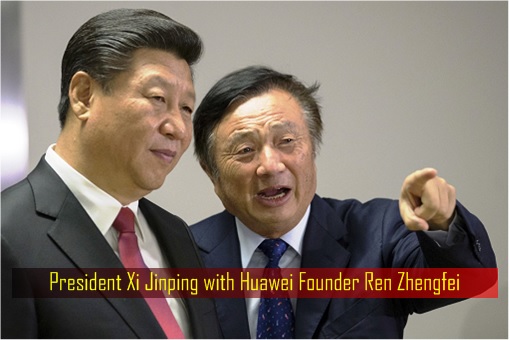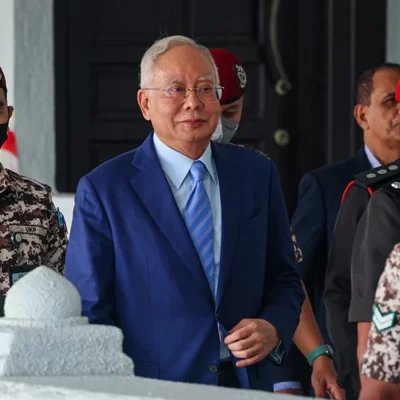Advanced chips, quantum computing and AI (Artificial Intelligence) are the future, and that was why the United States wanted to stop China from becoming a superpower – by destroying Huawei Technologies Co. The semiconductor is the means to that end, so the U.S. also must destroy Chinese mainland chipmaker – Semiconductor Manufacturing International Corp (SMIC).
For the last 4 years since Trump administration, Washington has been throwing everything, including the kitchen sink, in its open war with Beijing for technological supremacy. Biden administration was forced to continue his predecessor’s “Tech War” to the extent of cutting off Huawei entirely from the Western supply chains. The U.S thought it had won the war.
The release of Huawei’s 5G Mate 60 Pro smartphone on August 30, however, has not only shocked the U.S. and the world, but was also a slap in the face of Washington. The Chinese phone was not supposed to happen, not after the U.S. has imposed various export sanctions to prevent China’s access to powerful technology. The Mate 60 Pro’s microchip is hailed as a breakthrough.
But high-end microchip production is rocket science, involving sophisticated equipment and expertise which the Western nations convinced China did not possess. After all, the U.S., through persuasion, coercion and threats, has convinced the European Union, Japan, Taiwan and South Korea to restrict their companies from selling chips and chip-making equipments to China.
For example, ASML, the Netherlands-based producer of the world’s most advanced lithography systems, was pressured to restrict sending its chip-making equipments to China. The Dutch company has been barred from selling the most-advanced EUV lithography machines to China since 2019, though it had been able to still sell older generation “deep ultraviolet” DUV systems.
From January next year, the export ban on ASML’s advanced DUV equipment will kick in. ASML, Europe’s largest technology firm, is the exclusive EUV (extreme ultraviolet) lithography supplier for chip-making below 7-nanometre. China’s lithography imports reached US$3.96 billion in 2022 alone, with the Netherlands accounting for 64.3% (US$2.54 billion) of this figure.
Japanese lithography machine makers Nikon Corp and Canon Inc have also stopped exporting 23 types of chip-making equipment to China. Likewise, the U.S., the Netherlands and Japan have all restricted the exports of epitaxial wafers and etch, cleaning, deposition, annealing, metrology and related equipment to China. So, how was it possible for SMIC to produce the latest chip for Huawei?
Essentially, before the U.S.-led sanctions, the Chinese had already bought a lot of those machines. SMIC and other Chinese companies have the expertise to start making their own epitaxial wafers. Alongside Apple and Samsung, Huawei is one of only a few companies that has designed its own smartphone processor – through its own in-house chip design agency HiSilicon.
Previously, Huawei-designed chip was manufactured by TSMC (Taiwan Semiconductor Manufacturing Co). The Taiwanese chipmaker is the most advanced semiconductor manufacturer in the world. There is no Chinese company that can do what TSMC does. That’s why it sent shockwaves through the political and tech world when Huawei quietly released the Mate 60 Pro.
Yet, despite being restricted from buying American technology and blacklisted in the Entity List, Huawei and SMIC successfully designed and made Kirin 9000S chips using a 7-nanometer process – seen as highly-advanced in the world of semiconductors, even though it is not the latest technology. For years, SMIC struggled to make 7-nm chips because it did not have access to the EUV lithography machine.
It was speculated that SMIC may have “modified” the older manufacturing machines to make more advanced chips. However, if this is true, the process will be less efficient, which will translate to less profit because of reduction of the number of useable chips from each wafer. But some analysts said SMIC was using its 2nd generation 7nm-class fabrication process and stacking.
SMIC’s Twinscan NXT:2000i deep ultraviolet (DUV) lithography scanners can make chips on 7-nm and 5-nm technologies, so the company may have developed a 5nm-class fabrication process. Regardless whether it was 7nm-class or 5nm-class, the advanced packaging technology involved in producing the 12-core configuration chip using a “2+6+4 architecture” is a breakthrough.
Another theory from the U.S. Commerce Department was that SMIC has used American equipment to build the Kirin 9000S chip, which could be a sanctions violation. But do you really think Huawei cares about offending Washington at this stage? This could be the most likely scenario. CEOs Jensen Huang of Nvidia and Peter Wennink of ASML have warned that whatever the Chinese cannot buy, they will make themselves.
Wennick has also warned that the restrictive policies of Western governments are forcing China to become highly innovative. The Mate 60 Pro is still shrouded with mystery. For example, the smartphone does not even show “5G” signals on its status bar, prompting discussions whether it’s a 5G or 5.5G – even 6G – gadget. It could hit speeds up to 1Gbps or 1 gigabit-per-second.
At speed above the 100Mbps requirements for 4G networks, the Huawei’s latest gadget is definitely not a 4G phone. It has download speeds exceeding those of top line 5G phones. Call it whatever you want, but Mate 60 Pro is like a Nissan with a Ferrari engine. It’s hard to imagine how Chinese could reach such capabilities without access to the smartest minds working together.
Huawei’s CFO Meng Wanzhou, the daughter of Huawei founder Ren Zhengfei, said the company’s R&D investment jumped 13.2% year-on-year to 161.5 billion Yuan (US$23.5 billion) in 2022 – representing 25.1% of total revenue. Despite challenging times, its R&D (research and development) staff alone increased 6.2% to 114,000. In July, Mr Ren said – “Huawei will save talent, not US dollars”.
It was not a coincidence that Liang Mong-Song, managing director of SMIC who led the Chinese company to make the 7-nanometre chips was a former engineer at TSMC and Samsung. While he was condemned by pro-Taiwanese media as the traitor of TSMC, he was celebrated as a hero in the chip industry in China, alongside Huawei founder Ren Zhengfei.
What doesn’t kill Huawei will make it stronger. It’s too late – and futile – to further tighten the screws on China’s technological development with more sanctions. If the U.S. can’t kill the Chinese tech giant in the last 4 years, chances are it will be silly to try again. Huawei has already found the solution, otherwise it would keep a low profile instead of provoking the U.S. with the Mate 60 Pro.
Apparently, more than 90% of the components for the Huawei flagship smartphone are sourced locally, meaning the Mate 60 has become self-reliant and decouple from U.S. technologies. With over 10,000 components fully localized, the company obviously is making a comeback in the Chinese smartphone market. And if it was true that Huawei was a national security threat to the U.S., the nightmare has just begun.
If indeed the 7-nanometre chip could boost the Chinese military applications as trumpeted by Washington, the introduction of Mate 60 sends a message to the Biden administration that China can now produce as much chips as it wants. It is bad news for the U.S. government, which has been trying to slow down China’s ability to manufacture advanced chips over national security concerns.
Commercially, Ming-Chi Kuo, an analyst with TF International Securities, said he expects the Mate 60 Pro to ship between 5.5 to 6 million units for the second half of this year, up 20% from previously planned volumes. And cumulative shipments of Mate 60 Pro could reach at least 12 million units 12 months after launch, meaning Huawei will pose a bigger challenge to Apple in China than the geopolitical issue.
The Wall Street Journal reported that China had banned the use of Apple iPhones and other foreign-branded devices by central government officials. The restriction was in retaliation to similar bans taken in the U.S. against Chinese smartphone maker Huawei Technologies as well as and short video platform TikTok, owned by China’s ByteDance.
Apple stock plunged for two days after the reported restrictions – losing a whopping US$200 billion in market capitalization. Greater China, including Hong Kong and Taiwan, is Apple’s third-largest market, accounting for 18% of total revenue of US$394 billion. Even though the ban only affects less than 1% of the Chinese population, investors are concerned over a possible “domino effect”.
Back in 2019, Huawei was the King with a market share of 38%, while Apple had only 9%. It overtook Apple to become the world’s second-biggest smartphone seller, before Donald Trump tried to kill the Chinese giant. Clearly, the Mate 60 isn’t the only gadget to be rolled out. Even before the Mate 60, Huawei had increased its share of the China phone market from 7% in the second quarter of 2022 to 13% in the second quarter of 2023.
For years, even as recent as months ago, economic and military analysts have laughed at the idea that SMIC could produce 7-nanometre semiconductor chips. Even if China could produce it, it won’t be able to do it on a large scale at lower costs. But the fact that Huawei is taking new orders for millions of Mate 60 suggests that the U.S. could be wrong again about the Chinese capabilities.
And we have not even talked about Huawei’s mid-ranged Nova 5G phone, scheduled to be launched around November. Prior to Mate 60, all Huawei’s smartphones launched since 2021 were constrained to 4G due to suppress from the United States. The 7-nanometre chips produced by SMIC will not only power Huawei phones, but also surveillance cameras, data centres and other devices.
Heck, workers at Foxconn factory in Shenzhen who assemble iPhone are being offered a higher salary to assemble Mate 60. New workers at the Foxconn factory will be paid 26 Yuan (US$3.60) an hour to build Mate 60 compared to 21 Yuan (US$2.88) to assemble iPhone. Those working in the iPhone assembly lines could see their bonus slashed if Huawei eat into Apple’s sales and revenue.
Still, the U.S. must do something, or say something in order not to lose face. Commerce Secretary Gina Raimondo, who was humiliated when Huawei deliberately launched the Mate 60 while she was in Beijing, now says that the U.S. government doesn’t have any evidence that Huawei can manufacture 7-nanometre in large volume. Denial is the best strategy for now.
Source : Finance Twitter
The Coverage Malaysia






